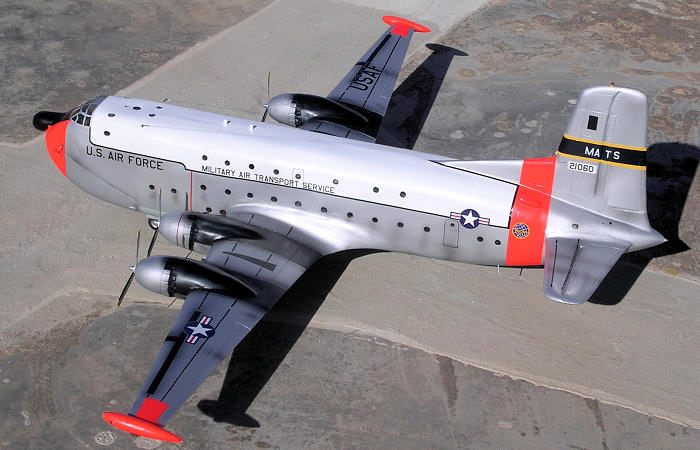
| KIT #: | 211 |
| PRICE: | 18 Euro MSRP |
| DECALS: | None |
| REVIEWER: | Carmel J. Attard |
| NOTES: |
U/c legs:
16.5 Euro; Anigrand decal sheet: 8.5Euro |

| HISTORY |
The C-124 evolved from the earlier Douglas C-74. To facilitate cargo
handling, the C-124, or "Old Shakey" as it was affectionately known, featured
"clamshell" loading doors and hydraulic ramps in the nose and an elevator under
the aft fuselage and two overhead cranes (each with a capacity of 16,000 pounds)
which could traverse the entire length of the 77 foot long cargo compartment. It
was capable of handling such bulky cargo as tanks, field guns, bulldozers, and
trucks. It could also be converted into a transport capable of carrying 200
fully equipped soldiers in its double-decked cabin or 127 litter patients and
their attendants.
The
C-124 carried a crew of seven consisting of:
Two
Pilots, two Flight Engineers, one Loadmaster, one Navigator and one Radio
Operator.
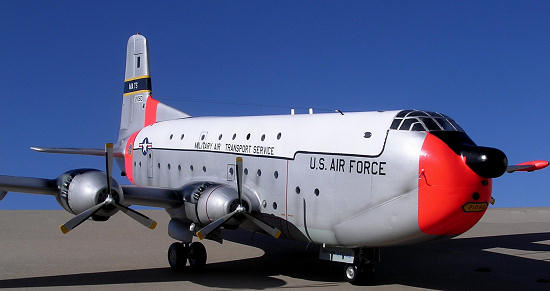 The first flight by a C-124 took
place on Nov. 27, 1949 and deliveries of C-124As began in May 1950. The C-124A
was followed into service by the C-124C, which featured more-powerful engines,
as well as wingtip-mounted combustion heaters that provided cabin heating and
wing and tail surface de-icing, and an
The first flight by a C-124 took
place on Nov. 27, 1949 and deliveries of C-124As began in May 1950. The C-124A
was followed into service by the C-124C, which featured more-powerful engines,
as well as wingtip-mounted combustion heaters that provided cabin heating and
wing and tail surface de-icing, and an
In mid September 1951, the 62d Troop Carrier Wing received it's first C-124 at McChord AFB but moved to Larson AFB, WA in April 1952. With the 62d absence from McChord the 1705th Air Transportation Group took over C-124 operations until the return of the 62d from Larson on June 13, 1960. It was at Larson AFB that the 62d was involved in the largest single aircraft accident at that time. On 20 December 1952, one of the 62nd's C-124s took off from Larson on a routine airlift mission. Immediately after takeoff, about one half mile from the runway, the Globemaster II crashed and burned, killing 87, including servicemen on leave, going home for the holidays.
McChord and other C-124 units went on to provide a much-needed airlift capability in the Korean War, as it was the only aircraft that could carry many of the Army's vehicles. It also performed many other missions such as resupply missions to Antarctica, refugee evacuation in the Congo and mercy flights to Morocco, Chile and elsewhere throughout the world following floods and other natural disasters.
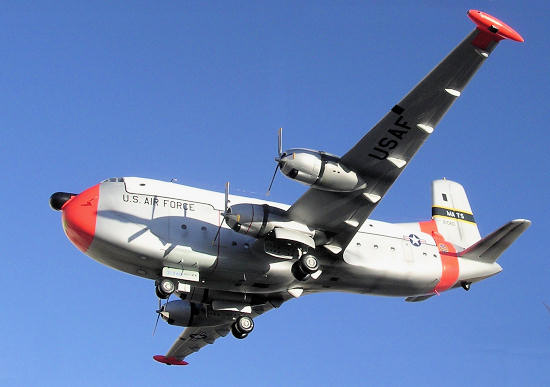 The USAF
bought 448 C-124A/Cs before production ended in 1955. Shortly after MATS became
the Military Airlift Command (January 1, 1966) and the 62d Air Transport Wing,
(Heavy), became the 62nd Military Airlift Wing (January 8, 1966) a new era began
for the 62nd when the unit received its first Lockheed C-141 Starlifter on
August 9 1966. As the unit took on C-141's it lost C-124's with the last of the
Globemaster IIs being transferred to the Alaskan Air Command (
The USAF
bought 448 C-124A/Cs before production ended in 1955. Shortly after MATS became
the Military Airlift Command (January 1, 1966) and the 62d Air Transport Wing,
(Heavy), became the 62nd Military Airlift Wing (January 8, 1966) a new era began
for the 62nd when the unit received its first Lockheed C-141 Starlifter on
August 9 1966. As the unit took on C-141's it lost C-124's with the last of the
Globemaster IIs being transferred to the Alaskan Air Command (
With the introduction of the C-141 into active service most C-124s were
transferred to the Air Force Reserve and the Air National Guard by 1970. The
first ANG unit to receive the C-124C was the last Air Force unit to retire their
aircraft (52-1066 & 53-0044) in Sept of 1974. C-124s that have landed at Hal-Luqa
airfield, Malta, prior to 1967 include those with serial Numbers and
corresponding dates when visited: 9.7.65 15207 and 20956; 26.8.64 015205;
28.2.65 021080; and in 1966 020955.
| THE KIT |
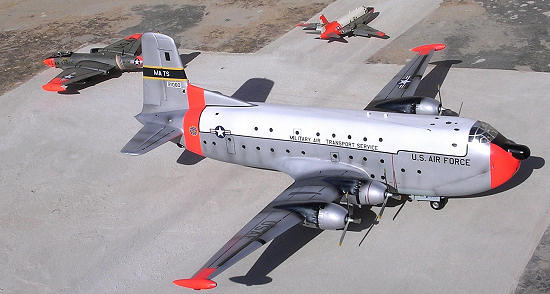 The kit is a vac-form type
and comes in two large sheets in white acetate and a smaller one in clear thick
acetate containing the cockpit canopy. The 22 “ X 16.5 “ instruction sheet
printed on both sides contain detail scale plans and an exploded view that is
good for reference during assembly. There are line drawings of the propeller,
nose and main landing gear, upper deck floor with detail cockpit crew office all
of which enable you to assemble components made from scratch built parts.
Drawings also indicate painting detail of the upper surfaces of the nacelles and
wing areas. Upon opening the kit polythene bags the kit looks impressive in view
of its enormous size with a bulky fuselage at the scale of 1/72. There are four
half parts for each engine cowling and nacelle combination. These appear crude
in appearance and addition there is the front part of the radial engine. There
is a certain amount of surface details on most parts, which were used as a guide
for further detailing. The impressed marks of the many portholes allover the
fuselage sides appeared to be in their correct place and of correct size. The
kit was also measured and found to be correct in both length and span.
The kit is a vac-form type
and comes in two large sheets in white acetate and a smaller one in clear thick
acetate containing the cockpit canopy. The 22 “ X 16.5 “ instruction sheet
printed on both sides contain detail scale plans and an exploded view that is
good for reference during assembly. There are line drawings of the propeller,
nose and main landing gear, upper deck floor with detail cockpit crew office all
of which enable you to assemble components made from scratch built parts.
Drawings also indicate painting detail of the upper surfaces of the nacelles and
wing areas. Upon opening the kit polythene bags the kit looks impressive in view
of its enormous size with a bulky fuselage at the scale of 1/72. There are four
half parts for each engine cowling and nacelle combination. These appear crude
in appearance and addition there is the front part of the radial engine. There
is a certain amount of surface details on most parts, which were used as a guide
for further detailing. The impressed marks of the many portholes allover the
fuselage sides appeared to be in their correct place and of correct size. The
kit was also measured and found to be correct in both length and span.
General comments
 Perhaps one of the
observations that one makes on the kit parts like the rudder, tail fin,
elevators, ailerons and wing trailing edges is the presence of lumpiness that is
common in early vac-form kits. However this proved to be of no difficulty as
these areas could be scraped with a knife blade after sanding down the kit
parts.
Perhaps one of the
observations that one makes on the kit parts like the rudder, tail fin,
elevators, ailerons and wing trailing edges is the presence of lumpiness that is
common in early vac-form kits. However this proved to be of no difficulty as
these areas could be scraped with a knife blade after sanding down the kit
parts.
The kit contains 10 major
items that includes the main wings, fuselage parts and tail planes. Besides
there are central sections and bulkheads that are shown in the explodes views.
These essential items are not among the kit parts so that one has to make the
scale drawing of the bulkheads and then cut them from the spare backing sheet. I
used plasticine (silly putty) to obtain the section contour and make my own
partial bulkheads at different s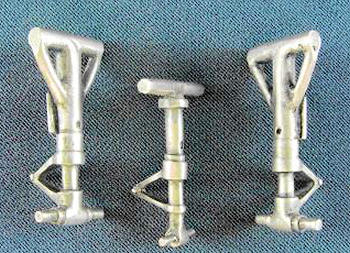 tations along the fuselage. I had no intention
to detail the cargo hold since any detail added would be barely visible through
the portholes. The 6-wheel bogie being split horizontally into two sections and
there was loss of hub detail that needed refining by carving using a pointed E-xacto
blade. A tool that proved to be handy for checking a vac-form kit of this size
was an outside caliper. this was used to check the width of fuselage while
sanding down the large fuselage halves. One major fault with this kit is the
lack of issuing an undercarriage suitable to hold the heavy and sizeable model.
Scratch building one made of plastic pieces would prove to be weak as the model
has to be handled tens of times during building. It is therefore recommendable
to obtain a set of oleo legs made of pewter from Ross of Dallas…e-mail address
is: Sacmactexas@aol.com The fuselage halves which matched correspondingly still
took a lot of filler to produce a smooth upper fuselage and hide the seam with
subsequent sanding and rescribing the panel lines.
tations along the fuselage. I had no intention
to detail the cargo hold since any detail added would be barely visible through
the portholes. The 6-wheel bogie being split horizontally into two sections and
there was loss of hub detail that needed refining by carving using a pointed E-xacto
blade. A tool that proved to be handy for checking a vac-form kit of this size
was an outside caliper. this was used to check the width of fuselage while
sanding down the large fuselage halves. One major fault with this kit is the
lack of issuing an undercarriage suitable to hold the heavy and sizeable model.
Scratch building one made of plastic pieces would prove to be weak as the model
has to be handled tens of times during building. It is therefore recommendable
to obtain a set of oleo legs made of pewter from Ross of Dallas…e-mail address
is: Sacmactexas@aol.com The fuselage halves which matched correspondingly still
took a lot of filler to produce a smooth upper fuselage and hide the seam with
subsequent sanding and rescribing the panel lines.
| CONSTRUCTION |
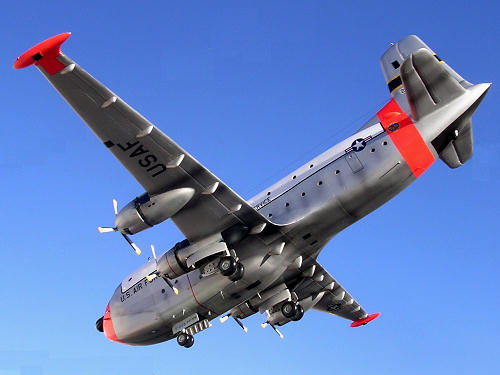 The kit build follows the
normal sequence of cutting and preparing parts as mentioned in previous examples
and rather than repeating same here are listed the important points useful in
making a robust kit of the Globemaster which is made from relatively soft vac-form
material that come with the Airmodel kit.
The kit build follows the
normal sequence of cutting and preparing parts as mentioned in previous examples
and rather than repeating same here are listed the important points useful in
making a robust kit of the Globemaster which is made from relatively soft vac-form
material that come with the Airmodel kit.
1) Ideally use a sheet of
medium grade wet and dry paper taped to a board. Trailing edges of wings and
rudder were sanded to thickness required and also scraped on the outside as
mentioned earlier. Panel lines were redrawn.
2) Cockpit area is cut out
using scissors and the edges trimmed to shape using a file. Having prepared the
fuselage halves the portholes are drilled and brought to shape with a round
file. This will ensure that when bulkheads and stiffeners are fixed they will
not come in the way of open portholes.
 3) Interior detail should be
decided at this stage. I decided to add a detailed crew office. This was made up
by first building a cockpit sub assembly and when completed it is transferred to
the kit for fixing in place. I drew a cockpit floor on a plastic card; on it I
fixed four crew seats as per instructions. Front and side consoled, instrument
panel, rear bulkhead, control wheels, rudder pedals and some other items shown
on instructions were all added. To the fuselage parts I also added alternate
tabs to both sides in order to self locate and secure the parts when brought
together. The kit needed lead weight. Cockpit interior were painted black, gray
and zinc chromate green.
3) Interior detail should be
decided at this stage. I decided to add a detailed crew office. This was made up
by first building a cockpit sub assembly and when completed it is transferred to
the kit for fixing in place. I drew a cockpit floor on a plastic card; on it I
fixed four crew seats as per instructions. Front and side consoled, instrument
panel, rear bulkhead, control wheels, rudder pedals and some other items shown
on instructions were all added. To the fuselage parts I also added alternate
tabs to both sides in order to self locate and secure the parts when brought
together. The kit needed lead weight. Cockpit interior were painted black, gray
and zinc chromate green.
4) Three plastic boxes were
constructed and made in such a way to fit at the lower deck of front fuselage
right under the cockpit floor. These boxes measuring 2” x ¾” square section were
to hold lead pieces to balance the kit on the nose. Loose lead was encased with
tissue paper and white glue and the boxes closed with glue, were then cemented
to forward area close to the nose
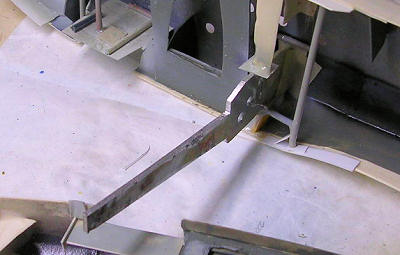 wheel well.
wheel well.
5) Other essential work to
be done before closing the fuselage was to cut slots to the wing root so that an
aluminum bracket that will hold the wings at the right dihedral will be
inserted. The bracket, made of Aluminum measured 9.75” x 26mm wide x 3 mm thick.
This can also be made of plywood. A jig was drawn from thick cardboard to hold
the wing at the correct angle of 8 degrees to the horizontal and retaining the
dihedral on each side while it is setting. A template made from thick cardboard
will check the correct distance of the inner engine nacelles from the fuselage.
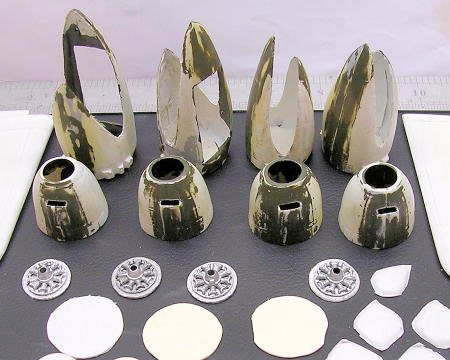 6) The engine nacelles
integral with cowlings and front radial engine piece were attended to in same
way as building a vac-form kit followed by rescribing the panel lines and
reshaping the exhaust pipes at the sides. These are the items that needed much
care when bringing them to attach to the wings.
6) The engine nacelles
integral with cowlings and front radial engine piece were attended to in same
way as building a vac-form kit followed by rescribing the panel lines and
reshaping the exhaust pipes at the sides. These are the items that needed much
care when bringing them to attach to the wings.
7) When assembling the
wings, these had support section brackets fitted chord wise starting from a
point 5” from the root i.e. away from the aluminum bracket mentioned in (5). The
position of the cowlings on the wing, which were incorrectly printed on the
wing, were altered and this was done AFTER the wings are attached to the
fuselage.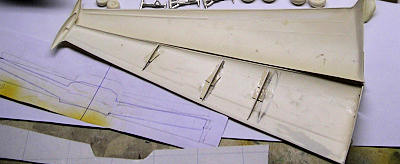 The wings were allowed to set for a day held with pegs and checked to
see that the shape is retained and remains level. The wings to fuselage were
another step that required checking twice or more over and the bracket that is
now protruding from each side of the fuselage, is inserted in the wings at each
side. With the wings in place and faired with a small amount of Filler they are
strong enough to withstand handling however it was noted that the outer wings
may not be strong to hold the bulky fuselage and during handling it is was safer
to grip the wings from the root area from then on. A fillet at the trailing edge
root area
The wings were allowed to set for a day held with pegs and checked to
see that the shape is retained and remains level. The wings to fuselage were
another step that required checking twice or more over and the bracket that is
now protruding from each side of the fuselage, is inserted in the wings at each
side. With the wings in place and faired with a small amount of Filler they are
strong enough to withstand handling however it was noted that the outer wings
may not be strong to hold the bulky fuselage and during handling it is was safer
to grip the wings from the root area from then on. A fillet at the trailing edge
root area 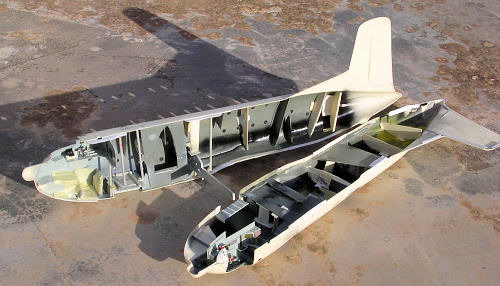 was not provided and had to be made from a piece of plastic card cut
in triangular shape and fitted and faired with Plasto.
The new place for the cowlings was marked using a template prepared to
check the distances from the fuselage for each side of the inner and outer
engines.
was not provided and had to be made from a piece of plastic card cut
in triangular shape and fitted and faired with Plasto.
The new place for the cowlings was marked using a template prepared to
check the distances from the fuselage for each side of the inner and outer
engines.
8)Building a model of this
size and the continuous handling it entailed it is imperative to have a sturdy
undercarriage and even better than plastic ones made of stretch sprue and runner
parts. Best way out is to get a metal undercarriage. This can be obtained from
Ross or
www.scaleaircraftconversions.com
9) Before fixing the
undercarriage legs it was essential to build a robust well roof and side walls.
Each well is boxed and fitted securely and detail added inside allowing place
where the oleo is to be fitted in the correct spot as displayed on scale plans.
Interior detail was made after studies of photos of wheel well interior
structures. The wheel doors were also detailed as best one could.
as displayed on scale plans.
Interior detail was made after studies of photos of wheel well interior
structures. The wheel doors were also detailed as best one could.
 The metal legs
that fits under wing well were fixed at an angle so that they are perpendicular
to the ground level.
The metal legs
that fits under wing well were fixed at an angle so that they are perpendicular
to the ground level.
10) I had a set of four
propellers which were modified by extending each at the tip simply by adding ¼”
piece of plastic card to each tip to form the 3-bladed right hand propellers.
Then shaped accordingly at their tip end.
11) There are 8 servo pods, which operate the flaps and ailerons. Some aircraft had only 5, which are closer to the fuselage. I fitted all the eight pods of different size the larger ones are nearer to the fuselage trailing edge. Their place was also relocated from the position they were printed in the surface after checking with scale plans. Air intake at the rear and other surface detail items were added to the kit.
| COLORS & MARKINGS |
The wheel hubs were first
painted silver, then masked with a round cut masking tape and painted in Acrylic
black. The astrodome carried by early C-124 was replaced with a clear round
skylight and treated in same manner as all the portholes. i.e. covered with
Kristal Klear at the end. I also noted that the wireless did not end at the top
of fin but at the lower part of the fin. The black areas were airbrushed in
Revell aqua color Schwarz gloss 36107, top fuselage airbrushed in Model Master
semi gloss white. The rest of the model was first masked the white and black
areas and airbrushed with a mix consisting of commercial silver made by Hample
(Malta) ltd, few drops of Model Master semi gloss clear lacquer and few drops of
gloss white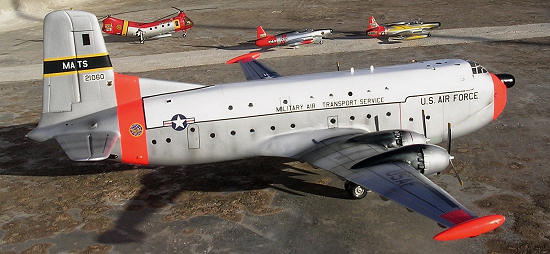 . Allowing time for paint to dry and the kit was given an overall
coat of Johnson’s Klear (improved formula).
. Allowing time for paint to dry and the kit was given an overall
coat of Johnson’s Klear (improved formula).
Decals were obtained from Anigrand for a
price but these had serial registration of a type less colorful than the one I
had in mind to do and these still needed modification. Micro scale came to the
rescue and I used all the cheat lines and walk way lines in black that were cut
from a solid black decal sheet. The nose yellow label was cut and slid on a
silver decal sheet to produce the silver outline that is placed on the nose
front area. The serial number written on it was replaced with a new one to suite
my livery for the type. The silver outline was also added to the upper surface
decals legend USAF that go over the black walkways. The White
| CONCLUSIONS |
The kit took around a month
and a half to build and it was the largest vac-form model I have made so far
(bigger than the Nimrod and the RC-135), a long continuous process leaving no
time to make other models in between and in the end it left a lot of
satisfaction as well as a sigh of relief.
| REFERENCES |
McChord Air Museum Foundation.
December 2010
Copyright ModelingMadness.com
If you would like your product reviewed fairly and quickly, please contact the editor or see other details in the Note to Contributors.